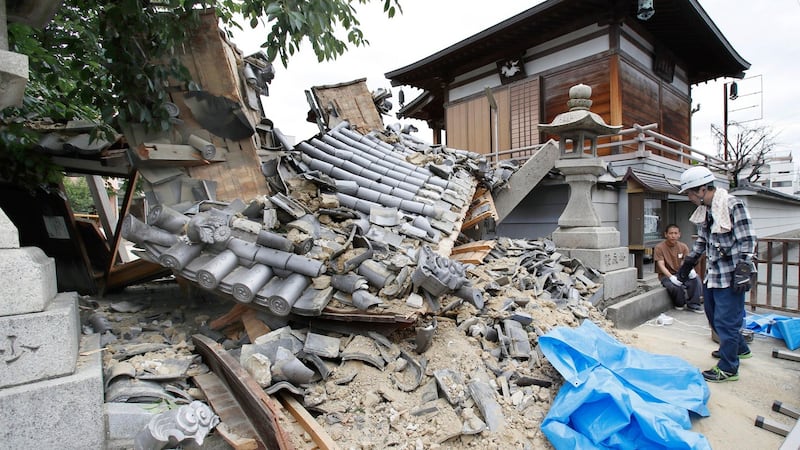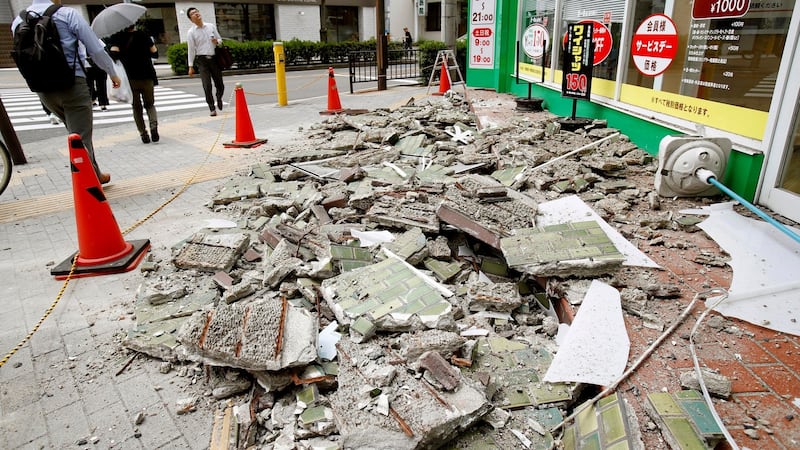A child crushed by a collapsing wall was among the victims of a powerful earthquake that struck around Osaka, Japan’s second-largest metropolis, on Monday morning.
The 6.1-magnitude quake killed at least three people and injured 120 others, some seriously, according to broadcaster NHK.
Japan’s Meteorological Agency said the quake struck shortly after 8am local time at a depth of about 13km (eight miles). The epicentre was north of Osaka, an important industrial hub and the host of next year’s Group of 20 Summit.
Gah! It’s terrifying, right? My phone went off in the middle of the quake! I was so near the epicenter that it didn’t provide early warning like it usually does…
— Kayleeだよぉ〜♡ (@kayleedayo) June 17, 2018
I’m alright! I saw some damage on my ride to work, though… ♡♡ https://t.co/mRIDlu0x4n
The strongest shaking was in this area, but the quake rattled large parts of western Japan, including Kyoto, the agency said.
Rina Miyake (9), was knocked down and killed by a concrete wall at her elementary school as she walked by.
Takatsuki mayor Takeshi Hamada apologised over her death because of the wall’s collapse. The structure was old and made of concrete blocks — a known risk in earthquakes.
Minoru Yasui (89) and Motochika Goto (85) were both crushed under falling objects in different areas, says NHK.
The quake stopped trains, halted flights at local airports and temporarily cut off electricity supplies to 170,000 homes. Schools closed and thousands of commuters were forced to walk to work.
The quake also knocked over walls, broke windows and set off scattered building fires. It toppled book shelves in homes and scattered goods on shop floors. It also cracked roads and broke water pipes, leaving homes without water.
No tsunami warning was issued. Prime Minister Shinzo Abe said authorities were assessing damage and their top priority was the safety of residents.

Industry
The quake struck an important industrial area of central Japan.
Osaka-based Panasonic said it was halting production at three of its plants. Daihatsu Motor Co, a unit of Toyota Motor Corp, stopped its factories in
Osaka and Kyoto while it checked for damage. It said it would resume operations at the
Osaka plant on Monday evening. Tractor maker Kubota Corp. said it halted two plants in the area, while air conditioner maker Daikin Industries Ltd suspended operations at two plants, one of which had restarted by noon. Honda Motor Co and Mitsubishi Motors said they were resuming operations after suspensions and safety checks. Sharp Corp also resumed work at a joint venture plant with parent Hon Hai Precision Industry that it had stopped for safety checks.
Shaking was widely felt across western Japan, including the city of Kobe, where a 7.3-magnitude quake in 1995 killed over 6,400 people.
The surrounding region is host to one of largest concentration of nuclear power plants in Japan but none had reported irregularities by Monday afternoon (local time).

Japan has probably the world’s most sophisticated early warning system for tremors and other natural disasters. The system sends a warning to mobile phones seconds before the quakes strikes.
Local residents in Osaka recorded their experiences on Twitter: “My phone went off in the middle of the quake! I was so near the epicentre that it didn’t provide early warning like it usually does…” said one.
The quake brought back painful memories of the 2011 disaster that struck off Japan’s northeast coast. The magnitude 9 quake and tsunami killed over 18,000 people, triggered a triple meltdown of the Fukushima Daiichi Nuclear Power Plant and displaced tends of thousands of people.
Japan accounts for about 20 per cent of the world’s strong earthquakes. The Japan Society of Civil Engineers warned this month that a powerful quake off the country’s south-eastern coast could cause 1,240 trillion yen (€9.76 trillion) in economic damage.
Experts say the probability of such a quake may be as high as 70-80 per cent over the next three decades. –Additional reporting PA and Reuters




